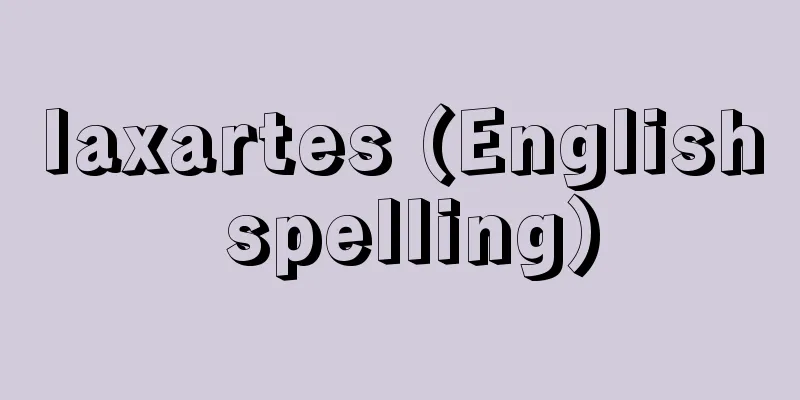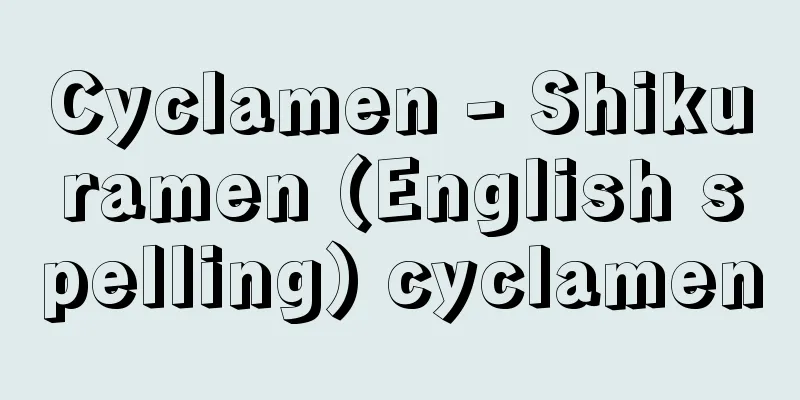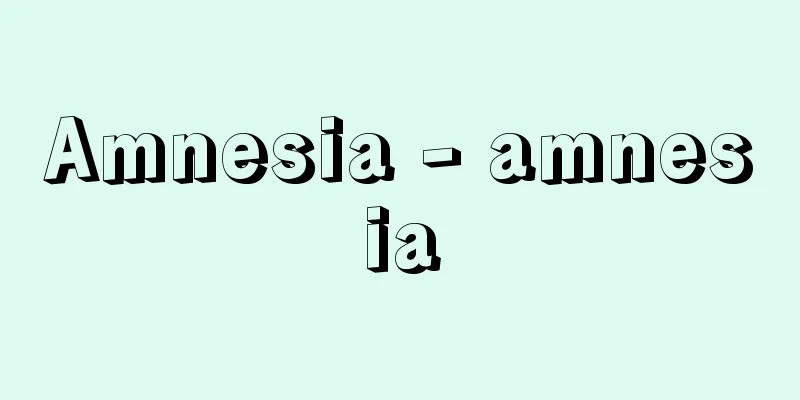Mediation - Conciliation

|
Generally speaking, it refers to the act of a third party acting as a go-between between the parties in a dispute, trying to reach an agreement through mutual compromise, with the aim of resolving the dispute as a result. To address this issue, national agencies and other bodies have established a mediation system to handle mediation cases through legal procedures and make them available to the parties involved. Legally, it refers to a procedure for resolving disputes that is called "mediation." For example, there are civil mediations (Civil Mediation Act, Part 3 of the Domestic Affairs Procedure Act), labor law mediations (Article 17 and following of the Labor Relations Adjustment Act), local government dispute mediations (Article 251 of the Local Autonomy Act), and for international disputes, there is international law mediation. [Takeyoshi Uchida and Tetsuo Kato, May 19, 2016] Civil MediationCivil mediation procedures are procedures in which the parties reach an agreement to resolve disputes through the mediation of a mediation committee established by the court. Since civil mediation falls under the broad definition of non-contentious cases, the provisions of Part 2 of the Non-Contentious Cases Procedure Act (Act No. 51 of 2011) apply mutatis mutandis to mediation unless otherwise specified (Article 22 of the Civil Mediation Act). In other words, there are civil mediation stipulated in the Civil Mediation Act (Act No. 222 of 1951) and family mediation stipulated in the Domestic Matters Procedure Act (Act No. 52 of 2011). As described below, family mediation is mediation conducted by a mediation committee established in a family court for cases that generally relate to the family, and civil mediation is conducted for other civil cases (for example, Chapter 2 Special Provisions of the Civil Mediation Act contains provisions for real estate mediation, agricultural mediation, commercial mediation, mining damage mediation, traffic mediation, pollution mediation, etc.). In civil cases, the parties are free to decide whether to seek a settlement through litigation or mediation. However, when the court deems it appropriate, it may use its authority to refer the case to mediation (Civil Mediation Act, Article 20). In civil mediation procedures, a mediation committee (Articles 5-8) consisting of one chief mediator designated by the district court from among judges and two or more mediators designated from among academics and experienced persons mediates the settlement of the dispute. There are no strict regulations regarding the procedure, and the content of the mediation does not have to be based on the law. This is because the purpose of the mediation is "to achieve a solution that is reasonable and in line with the actual circumstances through mutual concessions between the parties" (Article 1 of the same act). If an agreement is reached between the parties as a result of mediation and this is recorded in the record, the record has the same effect as a court-conciled settlement (Article 16 of the same act). Even if there is no prospect of a settlement being reached through the conciliation committee, the court may, if it deems it appropriate, hear the opinions of the civil conciliation committee members who make up the said committee, give impartial consideration to both parties, and, after considering all circumstances, make a decision of its own accord that is necessary to settle the case, to the extent that it does not contradict the purpose of the petitions of both parties (Article 17 of the same law). However, if a lawful objection is filed by a party or an interested party, this decision shall become void (Article 18 of the same law). Family cases, such as disputes over personal matters, are different in nature from ordinary civil cases, and therefore are often not suitable for public trial. For family cases, the Domestic Relations Procedure Act provides for family adjudication procedures and family conciliation procedures, and family courts have jurisdiction over them. Adjudication matters are listed in Book 2, Chapter 2 and the Schedule of the Domestic Relations Procedure Act, and are divided into two categories based on the nature of the case: matters that are not suitable for resolution through conciliation (Schedule 1 of the same Act) and matters that can be resolved through conciliation (Schedule 2 of the same Act). Adjudication matters are settled by a judge of the family court through adjudication, but the family court may at any time use its discretion to refer cases specified in Schedule 2 of the same Act to conciliation. In other words, all litigation cases over personal matters and other family cases in general may be conciliated, except for those specified in Schedule 1 of the same Act. Furthermore, anyone who wishes to file a lawsuit in such a case must first apply for mediation with the family court (Article 257 of the same law = principle of mediation as a prerequisite). This mediation is carried out by a mediation committee composed of one judge and two or more family mediation committee members (Article 248 of the same law). As described above, civil mediation is characterized by the fact that the parties are free to accept it or not, and that the mediation clause does not necessarily have to be based on law. [Takeyoshi Uchida and Tetsuo Kato, May 19, 2016] Labor Law MediationAlong with mediation and arbitration, it is one of the procedures for adjusting labor-management disputes. The conciliation committee established by the Labor Relations Commission conducts fact-finding investigations, such as by interviewing both labor and management, and then prepares a mediation proposal and asks both labor and management to accept it, thereby adjusting labor-management disputes. While mediation is a method of resolving disputes by clarifying the claims of both labor and management and mediating discussions between the parties, mediation is characterized by preparing a mediation proposal and seeking a resolution. However, in reality, even in the case of mediation, a "mediation proposal" is often presented to resolve disputes, and it is said that the difference between mediation and mediation has almost disappeared in practice (mediation has become mediation). For this reason, although mediation is more commonly used than arbitration among the procedures under the Labor Relations Adjustment Act, its use rate is very low compared to mediation, which has looser requirements. The mediation proposal prepared by the mediation committee only becomes binding when accepted by labor and management. This differs from arbitration, where once a party agrees to the initiation of arbitration proceedings, the party is necessarily bound by the decision of the arbitration committee. A conciliation committee is composed of members representing the public interest, employees, and employers. There must be an equal number of conciliation committee members representing labor and management (Article 20 of the Labor Relations Adjustment Law), and in practice, conciliation committees are usually composed of one conciliation committee member each from the public interest, labor, and management. In this respect, it differs from arbitration committees, which are composed only of public interest members or special adjustment committee members. However, in the case of mediation, in the vast majority of cases at the prefectural labor commission level, one public interest member each from labor and management are appointed as mediators, so in this respect, too, it is in effect composed the same as a conciliation committee. Conciliation committee members are appointed by the chairman of the labor commission from among the public interest, labor, and management members of the labor commission and the special adjustment committee members. Mediation begins when When mediation is initiated based on the voluntary will of both labor and management (including cases where one party applies for mediation but the other party agrees on it in a labor agreement beforehand), as in (1) and (2), it is called voluntary mediation, while when mediation is initiated without regard to the will of one or both parties, as in (3) to (5), it is called compulsory mediation. Compulsory mediation is permitted not only in cases where it significantly impedes public interest businesses or the public interest, as mentioned above, but also for specified independent administrative institutions and locally operated public enterprises (Article 27 of the Law Concerning Labor Relations of Administrative Execution Corporations, Article 14 of the Law Concerning Labor Relations of Local Public Enterprises). The mediation committee is required to prepare a mediation proposal within 15 days of the date of the mediation application, etc., and the prepared mediation proposal is presented to the parties and they are advised to accept it within a 10-day deadline (Article 26 of the Labor Relations Adjustment Law, Article 10 of the Enforcement Order of the same). If necessary, the mediation proposal may be made public to appeal to the power of public opinion. [Hideo Kinoshita and Mikio Yoshida] Mediation on local government disputesThis is a mediation system (Article 251 of the Local Autonomy Law) conducted by local government dispute mediators when there is a dispute between ordinary local public entities (prefectures and cities, towns and villages) or between their organs (for example, between assemblies and executive bodies, or between executive bodies). In cases where a prefecture or an organ of the prefecture is the party, the Minister of Internal Affairs and Communications will refer the matter to mediation upon the application of the party or by ex officio, while in cases where other parties are involved, the prefectural governor will refer the matter to mediation. This system has no binding power. In addition, there are separate systems for mediation of disputes over city/town/village boundaries, disputes between local public entities over the management of locally operated public enterprises, and disputes following city/town/village mergers. [Yasuhito Abe] International Law MediationIt refers to the peaceful resolution of international disputes, in which an independent institution established specifically for that purpose seeks to harmonize the claims of the parties to the dispute. While mediation (in-country conciliation) is a method of dispute resolution through the intervention of a third country, conciliation is a method through the intervention of an institution composed of independent committee members. Also, while international trials are generally based on the law and their judgments are legally binding, mediation is not necessarily based on the law and its resolution proposals are merely recommendations. Committees serving as conciliation institutions may be set up each time a dispute occurs, or may be permanent. The idea of international arbitration first appeared in the Knox Convention of 1911 and the Bryan Convention of 1913, both of which were concluded by the United States. From around 1924, many arbitration treaties were concluded, and the arbitration system was given an important position in the General Protocol for the Peaceful Settlement of International Disputes of 1928. Although not many disputes have actually been referred to arbitration, there is a tendency to once again value the arbitration system. For example, the United Nations Convention on the Law of the Sea allows for the settlement of certain disputes by arbitration at the option of the parties, in addition to the compulsory settlement procedure, while the United Nations Convention on the Law of Treaties provides that disputes regarding the invalidity or termination of a treaty shall be referred to a conciliation committee, and the International Covenant on Human Rights (ICCHR) provides that disputes not resolved by the Human Rights Committee shall be referred to an ad hoc conciliation committee. [Yasuo Ishimoto] [References] | | | | | | | | | | | | |Source: Shogakukan Encyclopedia Nipponica About Encyclopedia Nipponica Information | Legend |
|
一般的には種々の紛争解決にあたり、第三者が紛争当事者間を斡旋(あっせん)仲介して、当事者が互いに譲り合うことにより合意に達するように努め、その結果、争いを解決させることを目的とした行為をいう。そこで国家機関などが、調停にあたり、法定の手続により処理し、当事者が利用できるように設置したのが調停制度である。法律上は、「調停」の名称を付した紛争解決のための手続をいう。たとえば、民事上の調停(民事調停法、家事事件手続法第3編)、労働法上の調停(労働関係調整法17条以下)、自治紛争上の調停(地方自治法251条)などのほか、国際間の紛争については国際法上の調停などがある。 [内田武吉・加藤哲夫 2016年5月19日] 民事上の調停民事の調停手続は、裁判所に設けられた調停委員会の仲介によって、当事者間に紛争解決のための合意を成立させる手続である。民事の調停は広義の非訟事件に属するので、特別の定めがある場合を除いて、調停に関してはその性質に反しない限り、「非訟事件手続法」(平成23年法律第51号)第二編の規定が準用される(民事調停法22条)。つまり民事の調停には、「民事調停法」(昭和26年法律第222号)に規定されている民事調停と、「家事事件手続法」(平成23年法律第52号)に規定されている家事調停がある。家事調停は後述のごとく、家庭裁判所に設けられた調停委員会が一般に家庭に関する事件について行う調停であり、これ以外の民事事件については民事調停が行われる(たとえば、民事調停法第2章特則では、宅地建物調停、農事調停、商事調停、鉱害調停、交通調停、公害等調停などにつき規定を置いている)。 民事事件について、紛争の解決を訴訟に求めるか調停に求めるかは当事者の意思に任されている。しかし裁判所が適当と認めるときは、職権をもって事件を調停に付することもできる(民事調停法20条)。民事調停手続においては、裁判官のなかから地方裁判所が指定する調停主任1人と学識経験者のなかから指定された2人以上の調停委員により構成された調停委員会(同法5条~8条)が紛争解決の仲介をする。その手続については厳格な定めはなく、調停の内容も法律に依拠したものでなくてもよい。「当事者の互譲により、条理にかない実情に即した解決を図ることを目的」(同法1条)としているからである。調停の結果、当事者間に合意が成立し、これを調書に記載したときは、その記載は裁判上の和解と同一の効力を有する(同法16条)。また、裁判所は、調停委員会の調停が成立する見込みがない場合でも、相当であると認めるときは、当該調停委員会を組織する民事調停委員の意見を聴き、当事者双方のために衡平に考慮し、いっさいの事情をみて、職権で、当事者双方の申立ての趣旨に反しない限度で、事件の解決のために必要な決定をすることができる(同法17条)。しかしこの決定は、当事者または利害関係人から適法な異議の申立てがあったときは、その効力を失う(同法18条)。 人事についての争いなどの家庭に関する事件は、通常の民事事件とは異なった性質をもっているので、公開の法廷で争わせることを適当としない場合が多い。そこで、家庭に関する事件については、家事事件手続法で家事審判手続と家事調停手続を規定して、家庭裁判所がこれを管轄している。審判事項は家事事件手続法第2編第2章および別表に列挙されているが、それには事件の性質上から、調停による解決に適しない事項(同法別表第1)と、調停による解決も可能である事項(同法別表第2)の2種類に分けている。そして審判事項は、家庭裁判所の裁判官により審判によって決着がつけられるが、同法別表第2に定められている事件に関しては、家庭裁判所はいつでも職権で調停に付することができる。つまり、人事に関する訴訟事件その他一般に家庭に関する事件については、同法別表第1に定められている事件を除いて、すべて調停を行うことができる。また、このような事件について訴えを提起しようとする者は、まず家庭裁判所に調停の申立てをしなければならない(同法257条=調停前置主義)。この調停は、裁判官1人および家事調停委員2人以上によって組織された調停委員会によって行われる(同法248条)。以上のように民事上の調停については、当事者がそれを受諾するか否かの自由を有するとともに、調停条項はかならずしも法律に依拠したものである必要はない点に特色がある。 [内田武吉・加藤哲夫 2016年5月19日] 労働法上の調停斡旋、仲裁と並ぶ労使紛争の調整手続の一つ。労働委員会に設けられる調停委員会が、労使双方から事情を聴取するなど事実調査を行ったのち、調停案を作成し、労使双方にこの受諾を求めることによって労使紛争を調整する手続である。斡旋が、労使双方の主張を明確にし、当事者間の話し合いをとりなすことによって紛争を解決しようとする方法であるのと比べて、調停は、調停案を作成して解決を図る点に特徴がある。ただし実際には、斡旋の場合も「斡旋案」を提示して紛争の解決を図ることも多く、事実上、斡旋と調停との差異はほとんどなくなってきているといわれる(斡旋の調停化)。このため労働関係調整法上の手続のうち、調停は仲裁より利用されているとはいうものの、要件が緩やかな斡旋に比べて利用される割合はたいへん低い。調停委員会が作成した調停案は、労使が受諾したとき初めて拘束力をもつ。この点、いったん仲裁手続の開始に同意すれば、仲裁委員会の判断にかならず拘束される仲裁と異なる。 調停委員会は、公益、労働者、使用者の三者を代表する委員から構成される。労使を代表する調停委員は同数でなければならないとされ(労働関係調整法20条)、実際には公・労・使各1名の調停委員によって調停委員会が構成されるのが普通である。この点、仲裁委員会が公益委員または特別調整委員のみから構成されるのと異なる。しかし斡旋の場合、都道府県労働委員会段階では斡旋員に公・労・使各1名が指名されることが大多数であるため、この点でも実際上調停委員会と同じ構成となっている。調停委員は、労働委員会の会長が、労働委員会の公・労・使の各委員および特別調整委員のなかから指名する。 調停が開始されるのは、 (1)(2)のように労使双方の自発的意思に基づいて(調停申請は一方がしても、事前に労働協約で合意している場合も含めて)調停が開始される場合を任意調停といい、(3)~(5)のように、当事者の一方または双方の意思を問わずに調停が開始される場合を強制調停という。強制調停は、前述のように公益事業または公益に著しい障害を及ぼす場合のほか、特定独立行政法人等および地方公営事業についても認められている(行政執行法人の労働関係に関する法律27条、地方公営企業労働関係法14条)。 調停委員会は、調停申請などがあった日から15日以内に調停案を作成するものとされ、作成された調停案は、当事者に示されて10日以内の期限を付して受諾が勧告される(労働関係調整法26条、同施行令10条)。必要な場合には調停案は公表され、世論の力に訴えることもある。 [木下秀雄・吉田美喜夫] 自治紛争上の調停普通地方公共団体(都道府県・市町村)相互間またはその機関相互間(たとえば、議会と執行機関、執行機関相互間など)に紛争がある場合に、自治紛争調停委員によりなされる調停制度(地方自治法251条)。都道府県またはその機関が当事者になるものについては総務大臣、それ以外の者が当事者になるものについては都道府県知事が、当事者の申請に基づき、または職権により調停に付する。これには強制力はない。このほか、市町村の境界に関する争論、地方公営企業の経営に関する地方公共団体の間の紛争、市町村合併に伴う争論の調停については、それぞれ別個の制度がある。 [阿部泰隆] 国際法上の調停国際紛争を平和的に解決するために、とくにそのために設けられた独立の機関が紛争当事国の主張の調和を図ることをいう。仲介(居中調停(きょちゅうちょうてい))が第三国の介入による紛争解決方法であるのに対し、調停は独立の委員で構成される機関の介入による方法である。また国際裁判が原則として法を基準として行われ、判決が法的拘束力を有するのに対して、調停はかならずしも法を基準とせず、かつ解決案は単なる勧告にとどまる。調停の機関たる委員会は、紛争のつど設置されることも、常設的に設置されていることもある。 国際調停の構想が登場したのは、アメリカの締結した1911年のノックス条約や、1913年のブライアン条約が最初であるが、1924年ごろから多くの調停条約が結ばれ、1928年の国際紛争平和的処理一般議定書のなかでも、調停制度は重要な地位を与えられた。実際に調停に付された紛争は多くはないが、ふたたび調停制度を評価する傾向がみられる。たとえば海洋法条約では、紛争の強制的解決手続と並んで、ある種の紛争については当事国の選択により調停による解決手続を認め、条約法条約では条約の無効や終了に関する紛争については調停委員会に付託するものとされ、また、国際人権規約(B規約)では、人権委員会によって解決されない紛争については特別調停委員会に付託するものとされている。 [石本泰雄] [参照項目] | | | | | | | | | | | | |出典 小学館 日本大百科全書(ニッポニカ)日本大百科全書(ニッポニカ)について 情報 | 凡例 |
Recommend
Empusa muscae (English spelling)
...All members of this genus are endoparasites of...
Tijuana - Tijuana (English spelling)
A tourist city in Baja California, in the northwe...
Private Diplomacy - Minkan Gaiko
Diplomacy conducted at the private level, as oppos...
Viola, W.
From an artistic point of view, what is required ...
Kunigami
Okinawa Prefecture, Okinawa Island, north of Mt. Y...
Madura foot (English spelling)
…Leprosy is caused by the bacterium Mycobacterium...
van de Velde
Willem I van de Velde (1614-1693) was born in Leid...
Rosa multiflora - thorns
It is synonymous with wild rose of the genus Rosa...
IRB - International Relations Board
Institutional Review Board : An institutional ethi...
Male ant - Male ant
…There are characteristics such as the existence ...
Manuel des Amphitryons (English)
…He grew up in a wealthy family, with his grandfa...
Mokkoku (English name) Ternstroemia japonica
A small evergreen tree of the Theaceae family. It ...
Shop system
A system in which a labor union and an employer o...
Toyoda Mitsugi
Year of death: 12/5/1829 (12/30/1829) Year of birt...
Grouping
...The raw materials used for Tosa kozo are Akaso...









